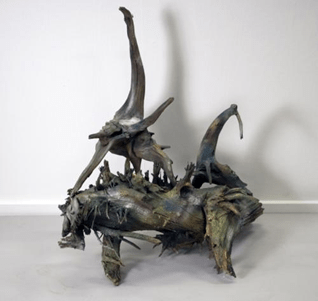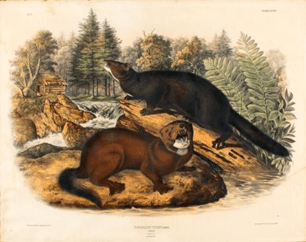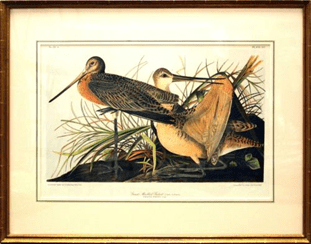Art, Animals, and Ecosystems
Animals, both real and imaginary, have played an important role in art. From scientific illustrations documenting native wildlife to raven rattles* used in important ceremonies, art helps us understand and connect with the natural world. Use this activity to discover animals in the Hunter’s collection and explore the relationship between animals and their ecosystems.
*For information on raven rattles, please see https://www.metmuseum.org/art/collection/search/501227
GRADES 1-5
Sciences
- LS2: Ecosystems: Interactions, Energy, and Dynamics: Develop and use models to compare how animals depend on their surroundings and other living things to meet their needs in the places they live. Predict what happens to animals when the environment changes (temperature, cutting down trees, wildfires, pollution, salinity, drought, land preservation).
- LS4: Biological Change: Unity and Diversity: Explain the cause-and-effect relationship between a naturally changing environment and an organism’s ability to survive. Infer that plant and animal adaptations help them survive in land and aquatic biomes.
- LS2: Ecosystems: Interactions, Energy, and Dynamics: Develop models of terrestrial and aquatic food chains to describe the movement of energy among producers, herbivores, carnivores, omnivores, and decomposers.
OBJECTIVES
After completing this activity, students will better be able to:
1. Discuss the relationship between animals and their physical environment
2. Define the terms ecosystem, adaptation, and habitat
3. Design a creature that can survive in a specific biome
4. Create an assemblage from found objects

Bessie Harvey (1929-1994), Untitled, c. 1985. Found wood, spray paint, nails, plastic eyes.
Bessie Harvey was a self-taught American artist, primarily known for her imaginative assemblages made from found objects and wood. Born on October 11, 1929, in Dallas, Georgia, Bessie Harvey (née White) was one of ten children born to her parents, Homer and Rosie Mae White. In her early twenties, Harvey relocated permanently to Alcoa, Tennessee, near Knoxville, where she worked as a housekeeper for Blount Memorial Hospital. Although interested in art since an early age, Harvey did not dedicate herself to making art full-time until her late forties. She first gained recognition for her sculptures in 1978 after entering an annual art show at the hospital where she worked. Harvey’s popularity soared in the early 1980s, and she eventually became recognized as an American sculptor. A year after her death, Harvey’s artwork was included in the 1995 Whitney Biennial, a major recognition for any artist.
SUPPLEMENTAL ARTWORKS

John James Audubon (1785 – 1851), Putorius Vison, Linn (Mink), 1844. Lithograph, no 7, plate 23.

John Woodhouse Audubon (1812-1862), Ursus Americanus, Pallar (Cinnamon Bear), 1847. Lithograph, no. 26, plate CXXVII

John James Audubon (1785 – 1851), John Great Marbled Godwit, unknown date. Chromolithograph.
VOCABULARY
Ecosystem – a community of interacting organisms and their environment
Habitat – the natural home or environment of an animal or plant
Environment – the surroundings or conditions in which a person, animal, or plant lives or operates
Adaptation – a change an organism goes through to better fit their environment
Herbivore – an animal that only eats plants. Rabbits are examples of herbivores.
Carnivore – an animal that eats meat. Sharks are examples of carnivores.
Omnivore – an animal that can eat both plants and meat. Humans are examples of omnivores.
Decomposer – organisms that can breakdown dead and decaying organisms. Mushrooms are examples of decomposers.
Assemblage – an artwork made by combining different objects
Found object – art made with everyday objects that have been discovered and gathered rather than traditional art materials which are purchased
DISCUSSION QUESTIONS
-
- Look closely. What do you see?
- How many hidden creatures can you find in Harvey’s artwork?
- Can you recognize the animals in Audubon’s art?
- Where do you think these creatures live? What might their habitat be?
- What do you think they eat? Why do you think they eat that?
- How are Harvey’s imaginary creatures different from Audubon’s real animals? Do they share any similarities?
- Many animals are uniquely adapted to their environments. What adaptations do think these creatures might have to survive in their environment?
ACTIVITY #1
While Audubon made illustrations of real animals in their natural habitat, Bessie Harvey created whimsical creatures from her own imagination. In this activity, students will design imaginary creatures that can survive in a specific habitat inspired by Harvey’s creative sculptures and Audubon’s scientific illustrations.
INSTRUCTIONS
- Prior to the lesson, have students collect found objects from their schools and homes. Students should look for clean and recyclable objects, like cardboard, paper rolls, bottles, and cans. If you do not have these materials, students can draw their creature on paper.
- Introduce Bessie Harvey’s artwork.
- Use discussion questions to encourage closer looking and group discussion.
- Explain how all animals have adaptations that help them survive. These adaptations can help animals find food, protect themselves from predators, or live in a specific environment. Turtles have hard shells that protect them from predators. Kangaroos have pouches that they use to carry their babies while they move. Catfish have gills that let them breathe underwater.
- Discuss how the imaginary creatures in Harvey’s artwork might survive in their natural habitat. What might they eat? What special adaptations might they have (ex. Camouflage skin, long necks)? How do these adaptations help them survive?
- Once students have the chance to discuss Harvey’s sculpture and review vocabulary, assign each student one of these habitats: forest, rainforest, desert, grassland, river, or ocean. It might be necessary to review the features of these habitats before students move on to the next step.
- Have students fill out the worksheet below with information about their animal.
- Once they have completed the worksheet, they can use it to design their creature.
- Using the found objects, students will create a model of the creature. They can use cans and bottles to make a body for their creature and pipe cleaners to make legs.
- After they finish, have students share their creatures with their class and explain how their creature is able to survive in its natural habitat.
MATERIALS
- Found and recycled objects, like cans, cereal boxes, milk cartons, paper cups, and cardboard
- Pencils
- Markers
- Googly eyes
- Glue
- Scissors
- Construction paper
Creature Worksheet
Creature Worksheet
Name: ______________________________
Habitat: _____________________________
Characteristics of this Habitat: ____________________________________
Creature Name: ______________________
My creature is a (circle one):
Carnivore – meat eater
Herbivore – plant eater
Omnivore – meat and plant eater
What does your creature like to eat?
_________________________________________________________
What special adaptations does your creature have?
_________________________________________________________
_________________________________________________________
How does your creature protect itself?
_________________________________________________________
_________________________________________________________
Is your creature a (circle one):
Predator – hunts and eats other animals
Prey – is hunted by predators


